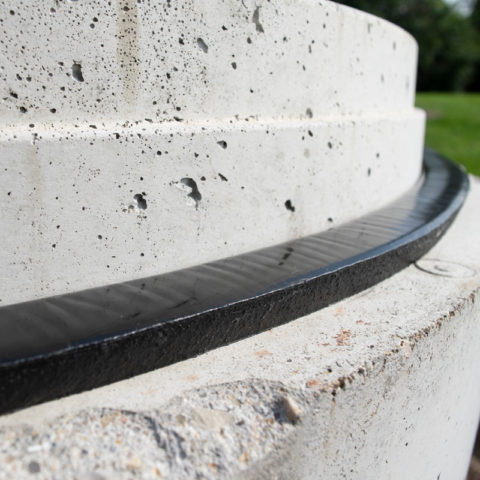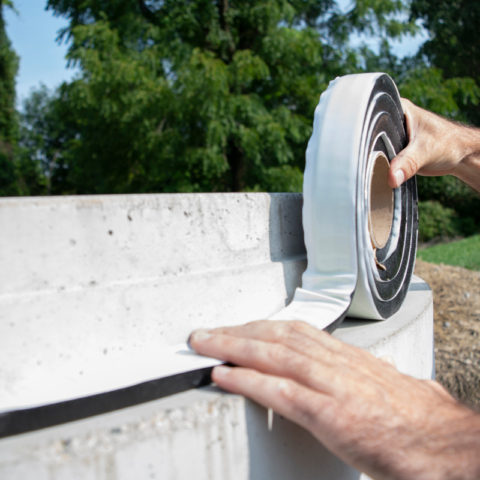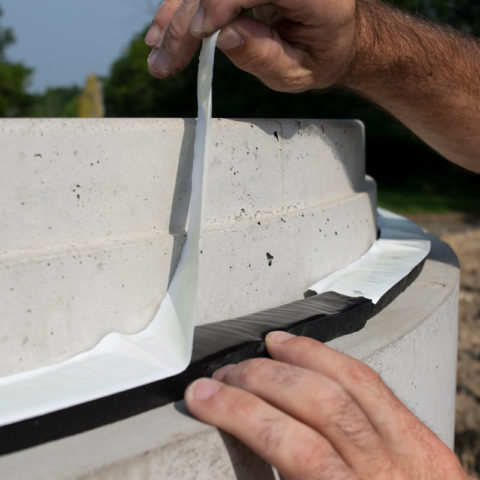
Crete Stik butyl/bitumen blend joint sealant is a rope form joint sealant that will not shrink, crack or dry out.
Document Downloads
Download Product Literature Download Box Culvert Literature Download Installation Instructions
How It Works
The Crete Stik should be sized such that the joint is filled to a minimum of 50% of its annular volume when fully assembled, and the Crete Stik should have the ends kneaded together at the overlap.
Testing of joints and compliance with specification requirements shall be conducted in strict conformance with the requirements of Press-Seal. For more information, refer to the full Installation Instructions.
Why It's Better
- Cost effective.
- Meets ASTM C 990 requirements for Compression Index per ASTM C 972.
- Starter strip leads to less waste per roll.
- Packaging designed to ensure proper dimensions.
- Improved release liner.
- Save on freight with bundling options.
- Adhesion works on a variety of surfaces including metal, glass and more.
Where To Use
Crete Stik is designed for underground infrastructure applications, including:
- Sanitary Manhole Joints
- On-Site Treatment Tank
- Stormwater Manhole Joint
- Stormwater Treatment Structure
- Stormwater Inlet Structure
- Irrigation and Drainage System
- Box Culvert
- Elliptical / Arch Pip
- Architectural Foundation
- Underground Utility Vault
- Grease Interceptor
- Wet Wells
Meets or Exceeds
CRETE STIK butyl joint sealant meets or exceeds all requirements of the following standards, specifications and/or test methods:
- ASTM C 990 – Standard Specification for Joints for Concrete Pipe, Manholes, and Precast Box Sections Using Preformed Flexible Joint Sealants
- AASHTO M 198 – Joints for Circular Concrete Sewer and Culvert Pipe Using Flexible Watertight Gaskets
- ASTM C 972 – Standard Test Method for Compression-Recovery of Tape Sealant
- ASTM C 765 – Standard Test Method for Low-Temperature Flexibility of Preformed Tape Sealants
The joints and/or joint surfaces of the structures shall be sealed with a butyl rubber based or butyl/bitumen blend preformed flexible sealant conforming to ASTM 990, ASTM C 765 Low Temperature Flexibility, ASTM C 972: Butyl sealants provide rebound for joint settlement and movement and ASTM C 972 Compression Recovery; compression index at 32° F, lbf/in³ 200 max.
The material shall be CRETE STIK, as supplied by PRESS-SEAL CORPORATION, Fort Wayne, Indiana, or approved equal. The material shall meet ASTM C990. For preformed joint sealants, the sealant shall be sized such that the joint is filled to 50% (min.) of its annular volume when fully assembled, and the sealant shall have the ends kneaded together at the overlap.
Primer and/or adhesive as recommended by the sealant supplier shall be employed for adverse, critical, or other applications.
Testing of joints and compliance with construction requirements shall be conducted in strict conformance with the requirements of the sealant supplier.
- Dry joint surface if wet.(Joint surface must be dry.)
- Clean all dirt, sand, mud, etc. from joint
- Remove roll from carton.(Keep away from dirt, etc.)
- Place exposed surface down/ place against vertical surface/press against concrete
- Apply sealant in continuous ring around the joint (DO NOT STRETCH!)
- To complete sealant ring cut off excess sealant with knife or sharp object
- Cut sealant so that when cut, the ends form a butt joint.(DO NOT OVERLAP!)
- Knead the ends together to finish sealant ring
- Remove protective release paper from the sealant ring
- Assemble the joint. Align structure section as straight as possible for proper entry of the tongue into the receiving groove and home the structure section. When the structure section is correctly joined, and a compression pressure obtained, PRO-STIK and EZ STIK butyl sealants will flow into a solid-pack and uniformly fill the annular space between the tongue and groove





